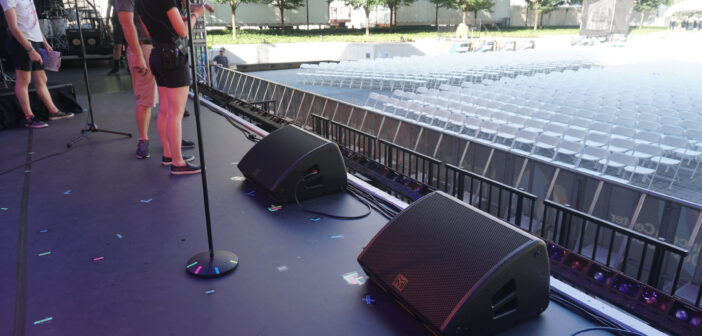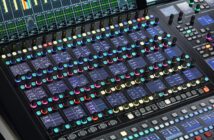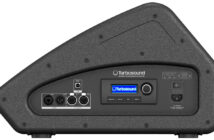Summary
- What Is a Stage Monitor and Why Is It Crucial?
- Positioning Your Stage Monitors for an Optimal Mix
- Active vs. Passive Monitors: How to Choose?
- Connect Your Monitors to a Mixing Console: Essential Steps
What Is a Stage Monitor and Why Is It Crucial?
Stage monitors are speakers placed on stage and aimed at the performers, allowing them to hear themselves and the rest of the band. Unlike front-of-house speakers that project sound to the audience, stage monitors are specifically designed for musician monitoring.
“Stage monitors are similar to full-range speakers, except they feature an angled design that lets them be positioned on the floor.”
They are essential for several reasons:
- Synchronization and cohesion: Each musician can clearly hear their own instrument as well as the other band members, which is crucial for maintaining synchronization and cohesion during a performance.
- Error reduction: By accurately hearing what’s being played, performers can adjust in real time, reducing mistakes and improving the overall quality of the performance.
- Personalized mix: Every musician has specific monitoring needs. For example, a singer may need more guitar and drums, while a drummer may prefer a different mix. Stage monitors allow this personalization.
There are different types of stage monitors, including active and passive monitors. Active monitors have a built-in amplifier, which simplifies setup. Passive monitors, on the other hand, require an external amplifier to operate.
In short, stage monitors play a crucial role in live performance by giving musicians precise control over what they hear, which is essential for high-quality musical execution.
Positioning Your Stage Monitors for an Optimal Mix
Positioning stage monitors is critical to ensure each musician can hear clearly and play in harmony with the rest of the group. Here are some tips for optimal placement:
- On the floor: Most stage monitors are designed to be placed on the floor, with an angled design that directs sound straight toward the performers. Make sure the speaker grille is aimed at the artist for better audibility.
- On a stand: If floor space is limited, some monitor models can be mounted on stands. This frees up space while maintaining good sound dispersion.
- Side fills: For large stages, consider using monitors placed on the sides, known as side fills. These speakers allow musicians to hear collectively, which is particularly useful for larger bands.
“Stage monitors are essential for musicians to hear themselves and play in sync. Good positioning can make all the difference.” – Sound reinforcement expert
It’s important to note that each musician has specific monitoring requirements. In large venues, you’ll generally see multiple stage monitors, often one for each band member. In smaller venues, like a café, a single speaker may be shared among several performers.
In short, proper positioning of stage monitors depends on your space configuration and the specific needs of each musician. By following these tips, you can significantly improve the quality of the on-stage mix.

Active vs. Passive Monitors: How to Choose?
When choosing between active stage monitors and passive ones, it’s essential to understand the fundamental differences between these two types of monitoring speakers.
Active monitors are equipped with a built-in amplifier, whereas passive monitors require an external power amplifier to operate.
Active monitors
Active monitors, also called powered speakers, are often preferred for their ease of setup. Here are some advantages:
- Easy connection: They connect directly to the mixing console via an XLR or TRS jack cable.
- Built-in controls: They generally have volume knobs and sometimes EQ options.
- Less gear: No need for an external amplifier, reducing the number of components to transport and configure.
To connect an active monitor, simply plug it into one of the auxiliary sends on the mixing console. This greatly simplifies the process, especially for those new to live sound.
Passive monitors
Passive monitors, by contrast, require an external power amplifier. Here are some points to consider:
- Flexibility: You can choose the amplifier that best suits your specific needs, allowing you to craft an optimal on-stage sound.
- Lighter weight: Without a built-in amplifier, passive monitors are often lighter and easier to transport.
To set up a passive monitor, follow these steps:
- Connect the mixing console outputs to the inputs of the power amplifier using balanced cables.
- Link the amplifier outputs to the inputs of the stage monitors with SpeakON, TS jack, or speaker cables, depending on the available connectors.
For more information on the different types of stage monitors and their configurations, see the buying guide.
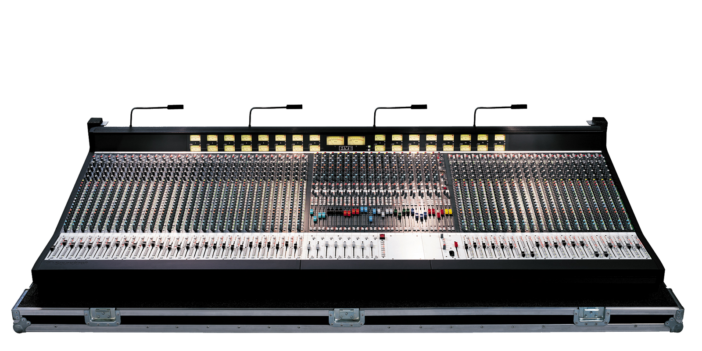
Connect Your Monitors to a Mixing Console: Essential Steps
Connecting stage monitors to a mixing console is a crucial step to ensure that performers on stage can hear themselves clearly. Here are the essential steps to get it right:
Note: Stage monitors are the speakers placed on stage that artists use to hear themselves and the rest of their band.
- Identify the type of monitors: The first step is to determine whether your stage monitors are active or passive. Active monitors have a built-in amplifier, while passive monitors require an external amplifier.
- Connecting active monitors: If you have active monitors, the process is relatively simple. Use an XLR or TRS jack cable to connect the active stage monitors to one of the auxiliary (AUX) sends on the mixing console. The balanced connectors on active monitors make this connection straightforward.
- Connecting passive monitors: For passive monitors, you’ll need an external power amplifier. Connect the AUX outputs of the mixing console to the inputs of the power amplifier using a balanced cable. Then use a SpeakON, TS jack, or speaker cable to link the amplifier outputs to the inputs of the passive stage monitors.
- Setting levels: Once the connections are made, adjust the output levels on the mixing console. Ensure the AUX send knobs are properly set to route signal to the stage monitors. On each channel strip, use the AUX pots to control how much of each instrument or microphone is sent to the monitors.
- Test and adjust: After making the connections, test the system by playing music or speaking into the microphones. Adjust levels and EQ to achieve a clear, balanced sound in the stage monitors.
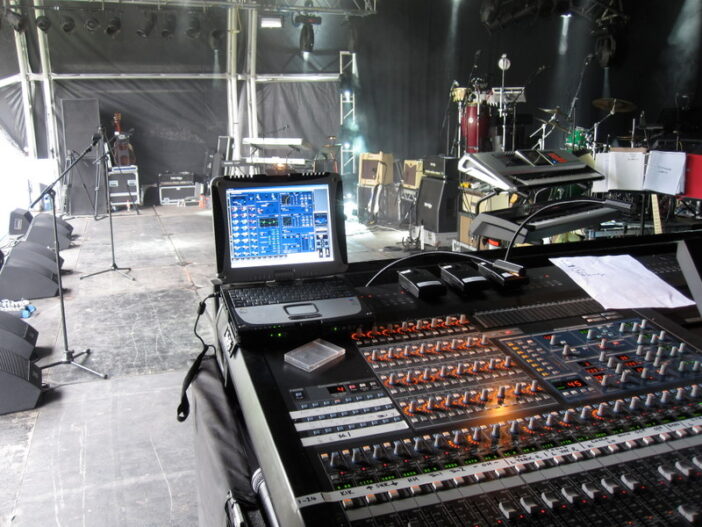
What is a stage monitor and why is it crucial?
Stage monitors are speakers aimed at the musicians for optimal monitoring. They are essential for synchronization, cohesion, and a personalized mix. Learn more about stage monitors.
What’s the difference between an active and a passive stage monitor?
Active monitors have a built-in amplifier, while passive ones require an external power amplifier. This distinction affects the connection method.
How do I connect an active monitor to a mixing console?
Use an XLR or TRS jack cable to connect the active monitor to one of the mixing console’s auxiliary (AUX) sends.
How do I connect a passive monitor to a mixing console?
Connect the AUX outputs of the mixing console to the inputs of the power amplifier, then connect the amplifier to the passive monitors with SpeakON, TS jack, or speaker cables.
Where should I place stage monitors for an optimal mix?
Place them on the floor angled toward the musicians, on stands to save space, or as side fills for collective listening.
Which cables are needed to connect active monitors?
An XLR or TRS jack cable is required to connect active stage monitors. Cable types guide.
Which cables are needed to connect passive monitors?
Use balanced cables to connect the mixing console to the amplifier and SpeakON, TS jack, or speaker cables to link the amplifier to the passive monitors.
Can I use a standard mixing console for stage monitors?
Yes, but make sure your mixing console has enough AUX outputs to manage the stage monitors. Best mixing consoles.
How do I adjust stage monitor levels?
Use the AUX pots on each channel strip to control the volume of each instrument in the monitors.
What should I do if no sound comes out of the monitors?
Check the connections, ensure the AUX levels are correctly set, and test the system with music or microphones.

